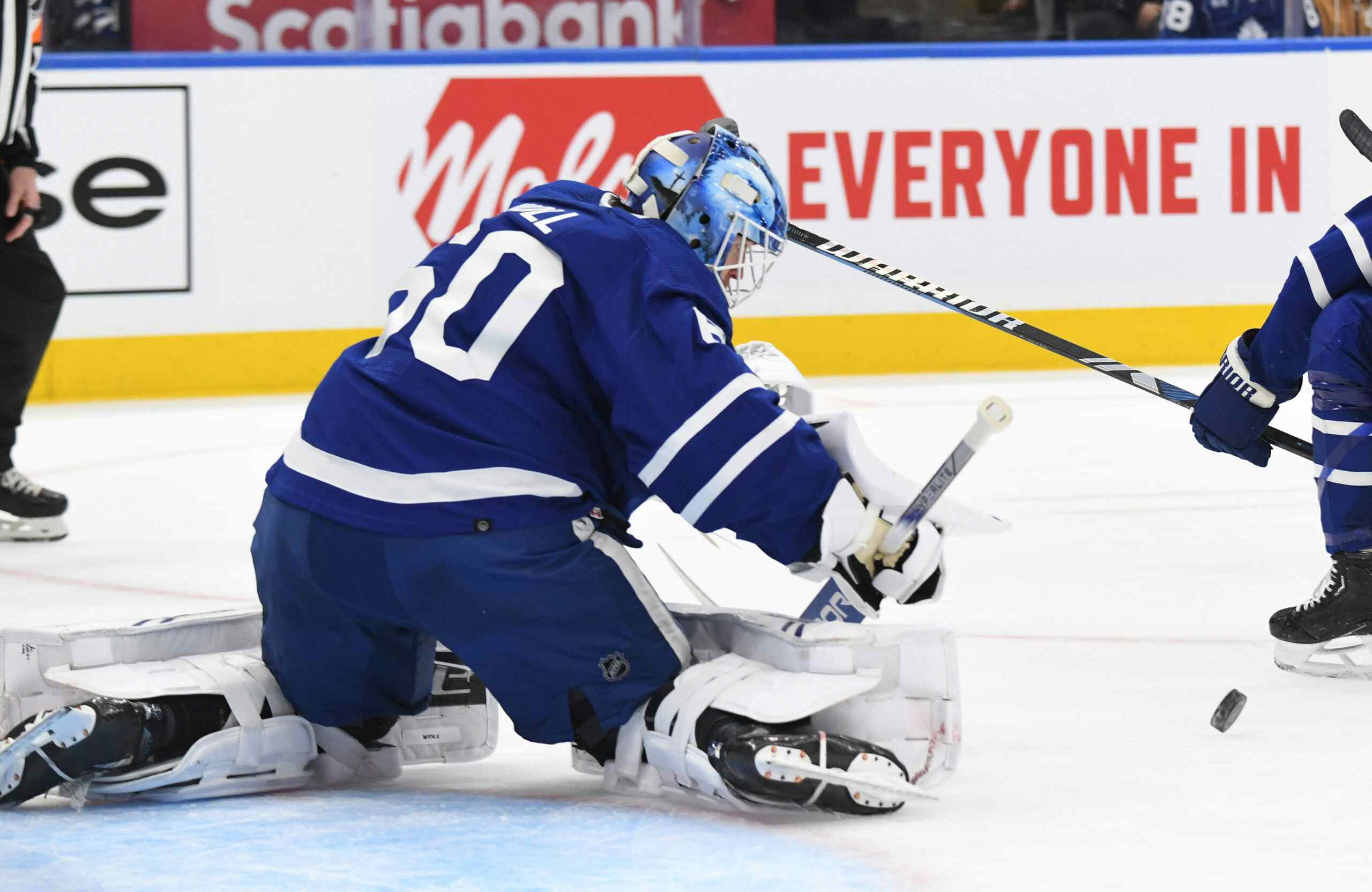How does the Maple Leafs blueline stack up against the Blue Jackets blueline?

By Brendan Mori
3 years agoOn Tuesday, NHL Commissioner Gary Bettman announced the league’s Return to Play plan. Our very own Scott Maxwell wrote more about the plan here. This plan confirmed that the Toronto Maple Leafs will play a best-of-five series against the Columbus Blue Jackets in the Play-In round.
In today’s article, I wanted to take a look at the Maple Leafs and Blue Jackets defense and see how they stack up against one another in a five-game playoff series.
The Defense
Below is the defensive depth chart for the Leafs and Blue Jackets. The tables are ranked based on the average amount of shifts each player received during the regular season.

Stats from NHL.com
At first glance, both teams heavily tested their defensive depth this season. Travis Dermott started the year on Injured Reserve, Morgan Rielly, Jake Muzzin and Cody Ceci all made trips to the IR as the season progressed. Tyson Barrie is the lone defenseman on the Leafs to have played in all 70 games this season. In Columbus, Seth Jones, Zach Werenski, Ryan Murray and Markus Nutivaara all missed games due to injury this season. The extended time off due to quarantine has certainly helped both teams get healthy.
The Advanced Stats

Stats from PuckIQ.com
When comparing the two defensive groups, the advanced stats show us the contrasting playing styles each team plays. The Leafs defense are active participants in creating offense and generating shot attempts, led by Rielly, Barrie and Muzzin. In Columbus, the Blue Jackets generate far fewer shot attempts from their defensemen not named Seth Jones and Zach Werenski. The big gap in shot attempts come down to stylistic play. Columbus is more content on grinding teams down and working the puck below the goalline, whereas Toronto will actively incorporate their defensemen into the offensive play.
Defensively, both groups give up their fair share of shot attempts, with both teams being middle of the pack in this regard. The big difference is the quality of these shot attempts. The DFA/60 (Dangerous Fenwick Against) stat aims to determine the danger level of shot attempts against your team. A DFA/60 rating in the 30’s suggests the player is good at suppressing quality shot attempts. If we look at the Blue Jackets defensive group, all six grade out incredibly well in this regard. This lines up well with the fact that John Tortorella coached teams historically block a lot of shots. This season, the Blue Jackets blocked 1,060 shots, averaging 15 blocked shots per 60, putting them inside the top five league wide.
On the Leafs end, only Justin Holl and Travis Dermott fare well by this standard, with the other four Leafs defensemen grading out as average or below average. The Leafs were very inconsistent defensively this season and there are a lot of reasons as to why this is was the case but ultimately, these advanced stats suggest the team is not as bad defensively as they look on TV. One positive to take out of this is that Columbus is not a strong offensive team, averaging 2.6 goals per game this season.
Three Questions on the Blue Jackets Blueline:
1. Can the Leafs shut down Zach Werenski?
John Tortorella has referred to Zach Werenski in the past as a “rover” meaning he is roaming all over the ice (in a good way). You’ll see him join or even lead the rush, or activate from the blueline to create offense, but then you’ll also see him be the first guy back to break-up a play in the defensive end.
Failed to load video.
Count how many goals Werenski scored this season where he is at or below the hashmarks. Werenski has the uncanny ability to “get lost” in the offensive zone and creep in at the right time. If he is given the ability to roam around the ice and generate offensive chances, then the Leafs will be in trouble.
Eight Leafs defensemen scored at least one goal this season, adding up to 23 goals collectively. That mark just barely beats out Werenski’s 20 goals. Further to this, Werenski scored an impressive 14 of his 20 goals at even-strength.
The key to shutting down Werenski is to clog up the neutral zone, make it hard for him to use his elite skating ability to gain entry into the Leafs zone, force him to have to either regroup or dump the puck into the leafs zone. When the Blue Jackets are in the Leafs zone, whatever winger is covering Werenski at the point has to make a conscious effort to shoulder check and stick with him, as he’s not afraid to slide down into the slot for a scoring chance. On top of this, closing the gap and getting into lanes and taking away his time and space will be vital in keeping him honest when he has the puck in the offensive zone.
2. How will their defensive pairings look?
Similar to how the Leafs can boast having two number one centers in Auston Matthews and John Tavares, Columbus has the incredible luxury of rolling out two number one defensemen in Seth Jones and Zach Werenski, either together or on different pairs.
One thing that will be interesting to watch when this series starts is how Tortorella deploys Jones and Werenski. Do you load up your top pair and play both of them (presumably) against Matthews’ line? Or do you play them on separate pairs to try and neutralize both Matthews and Tavares’ lines? When played together, they are one of the best pairings in the league. When separated, we have seen Jones paired most frequently with Ryan Murray (when he’s healthy) and Werenski paired up with David Savard and more recently Markus Nutivaara.
If Werenski – Jones is the team’s top pairing, who rounds out the bottom two pairings? Due to injury, Columbus created the Gavrikov – Savard pairing and watched them flourish together. This pairing logged 751:37 TOI together, behind only the Werenski – Jones pairing at 763:36 TOI.
Columbus has a deep defensive group, with all six players having the ability to play top four minutes.

3. Can Ryan Murray stay healthy?
Ryan Murray and the injury bug, name a more iconic duo. In his seven seasons with the Blue Jackets, Murray has played all 82 games in a season just once. This season, Murray suited up in only 27 games, dealing with a reoccurring back issue, amongst other things. Murray missed the Blue Jackets historic playoff run last spring due to injury and will be looking to put his injury woes to rest for good.
When Murray is in the lineup for Columbus, he offers a steady two-way presence and the ability to play anywhere in the top four. Depending on his health and how Tortorella wants to deploy his defense, Murray could very well see time against one or both of Auston Matthews and John Tavares in this play-in series. With Murray in the lineup, John Tortorella has a safety net to turn to if rookie Vladislav Gavrikov struggles or if he needs to change things up. If he’s not in the lineup, Tortorella will have to learn that much harder on his top pair and David Savard to get the job done.

Jan 8, 2020; Toronto, Ontario, CAN; Toronto Maple Leafs defenseman Tyson Barrie (94) carries the puck against the Winnipeg Jets at Scotiabank Arena. Winnipeg defeated Toronto in an overtime shoot-out. Mandatory Credit: John E. Sokolowski-USA TODAY Sports
3 Questions on the Leafs Blueline:
1. How will the right side fare?
The Leafs enter this play-in series against the Blue Jackets with a right side defense that is probably the best one iced in the Auston Matthews era, but one that is still riddled with holes and question marks.
Tyson Barrie is the latest defenseman acquired to try and shore up the right side. Offensively, Barrie had a down year, only rediscovering his offensive game once Sheldon Keefe was promoted to Head Coach in late November. In the defensive zone, I would argue Barrie came as advertised. Nobody was calling him a defensive stud by any means, but he is good at making breakout passes and getting the puck to the forwards. The problems in his defensive game stem from a lack of physicality and ability to break the cycle or down-low puck play.
Overall, I would say Cody Ceci exceeded expectations in Toronto this season, although it would have been hard not to given the expectations were pretty much at zero for him. For most of the season, Ceci looked fine, passing both the eye and advanced stats tests on many nights. Where Ceci starts to falter is in his decision-making, most notably when the opposing team pressures him upon puck retrieval. This is where Ceci struggled mightily, often turning the puck over or making a mistake that leads to a scoring chance against.
The 2019-20 season was widely seen as Justin Holl’s last shot to becoming an NHL regular. Holl had only played 13 NHL games in the previous two seasons, including being a healthy scratch in 71 of the Leafs 82 games last season. After being scratched in the season opener against the Ottawa Senators, Holl managed to get into and stay in the lineup on a nightly basis. Once Sheldon Keefe took over, Holl started to really take off, forming a solid shutdown tandem with Jake Muzzin and becoming a revelation of sorts for the Leafs as the season progressed.
In the 2018 playoffs, we saw the Boston Bruins target the Leafs right-side defense as a means to generate offensive zone time and scoring chances. Each shift, the Bruins made a conscious effort to keep the puck away from the Leafs left-side defensemen by dumping the puck into the right corner. This meant the teams weaker right-side would have to try and breakout the puck (they couldn’t).
I would argue the Blue Jackets playstyle is as heavy or heavier than the Bruins. This will be interesting to watch unfold as the Leafs are not built for a heavyweight matchup. If the Blue Jackets forwards establish a heavy forecheck early on, this could be an interesting series for the Leafs blueline.
2. Will we get to see Rasmus Sandin?
With Travis Dermott starting the year on IR, there was an opening on the Leafs blueline. Rasmus Sandin burst onto the scene in September and won that spot in training camp. He showed tremendous poise and confidence beyond his years in the preseason that even impressed then head coach Mike Babcock. Sandin played six games for the Leafs before being returned to the Marlies to make room for Dermott to return. Sandin would spend the remainder of 2019 with the Marlies and was even loaned to Team Sweden for the World Juniors. Once he returned, the Leafs recalled him, ravaged by injuries on defense. Sandin continued to shine and look like a seven-year veteran, not a rookie.
Unfortunately for him, this extended layoff helped the Leafs get back to full health and therefore pushes Sandin down the depth chart. We can debate who would be more effective in Sandin vs. Ceci, but ultimately as Mike Babcock once said, “tie goes the veteran”. There is definitely some benefit to having Sandin around to soak up the NHL playoffs as a black ace. For starters he can see up close just how intense and high stakes the playoffs are. Sandin will also have the ability to work directly with the Leafs player development staff during the postseason to further improve and refine his game.
So could we see Rasmus Sandin in the 2020 playoffs? The short answer is probably not. The long answer is that the Leafs would probably need to lose one, possibly even two defensemen before Sandin gets into the lineup. If a right-shot defenseman goes down, I would expect Martin Marincin to be slotted into the lineup. If a left-shot defenseman goes down, it’s probably a coin-toss between Sandin and Marincin.
3. Will the Leafs actually play defense?
If you look up and down the Maple Leafs blueline, Jake Muzzin is probably the only defenseman on the list that you could comfortably say is known for his defensive play. You could probably throw Justin Holl in there after the season he had, but its only been one season. Tyson Barrie is an offensive defenseman and while Morgan Rielly has made tremendous strides in the defensive end, he is still not elite defensively. Travis Dermott is still only 23 and in his third NHL season. Cody Ceci is deployed like a reliable defensive defenseman but still has some kinks to iron out.
The Leafs are going to need play defense by committee in this series against Columbus. This means the forwards backchecking and helping out the defense in their own end. This means not cheating for offense and flying the zone early, but a commitment to getting the puck out of the defensive zone first (preferably with possession). This also means the Leafs are going to need Freddy Andersen to not show up in October form, but at the very least his normal .918 save percentage self.
The Leafs as a whole gave up 3.2 goals-against per game this season, the 26th worst in the NHL. Their penalty kill was not that much better, ranking 21st in the NHL at 77.7%. The good news is that I doubt Sheldon Keefe and the rest of the coaching staff have just been lounging around in quarantine. I would expect they have identified areas of weakness and ways to change or fix these weaknesses for the playoffs.
The fortunate part is that Columbus does not boast a strong powerplay or goal scoring prowess. The Blue Jackets powerplay ranked 27th in the league at 16.4%. Columbus also averaged 2.6 goals per game, which was 27th in the league as well.

Final Thoughts
The Blue Jackets defense will force the Leafs to earn every inch of ice in the offensive zone in this series. On the Leafs side, I would expect them to be able to weather the storm defensively, but I would not expect it to be or look pretty.
I’ve touched on this a few times in this post. It will be interesting to see how the pairings look for both teams when game 1 starts in the summer (that was weird to type). Leafs fans have seen Sheldon Keefe make some bold lines and pairings for this team since he took over and I would definitely bet on the pairings he starts the game with not being the same when the game is almost over.
If you asked me to chose one of these defensive groups for my dream team, I’m probably going with the Blue Jackets defensive group, but its close. The deciding factor for me is the flexibility their defensive group offers. All six players can play in the top four and can contribute and be effective. On the Leafs end, there is a lot of unknown with their group and also the fact that certain guys can only be played in certain situations to truly be effective. There is also the fact that the Leafs defensive group does not offer a lot of flexibility in terms of pairing options (on paper Muzzin – Rielly is the dream, but Rielly is not as effective on the right-side).
Data from naturalstattrick.com, PuckIQ and NHL.com
Recent articles from Brendan Mori





